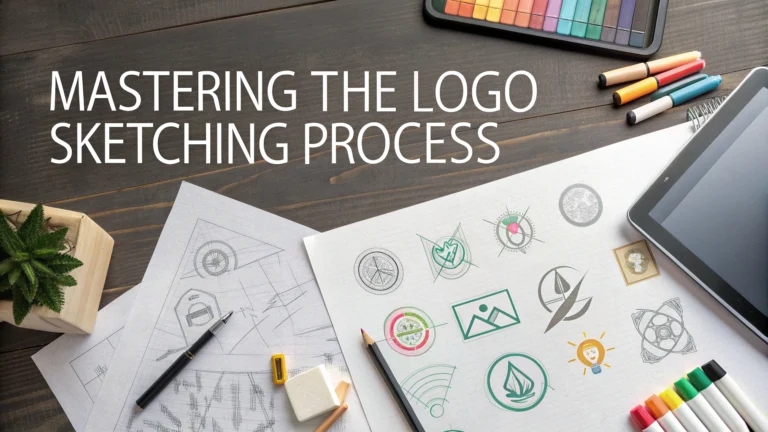A well-designed logo starts with effective sketching, and this quick guide breaks down the essential steps of the logo sketching process.
Setting Up Your Sketching Space
Gather basic materials: quality paper, pencils (2H through 2B), erasers, and a ruler.
Research Phase
- Study competitor logos in your client’s industry
- Create a mood board with visual references
- Document client requirements and brand values
- Research cultural implications of symbols and shapes
Thumbnail Sketching
Start with rapid, small sketches (about 2×2 inches) to explore multiple concepts quickly.
Basic Shapes First
- Circles for harmony and completeness
- Squares for stability and trust
- Triangles for direction and energy
- Organic shapes for natural elements
Refinement Process
- Select 3-5 strongest concepts from thumbnails
- Develop larger versions (4×4 inches)
- Test different weight variations
- Explore negative space opportunities
Common Sketching Mistakes to Avoid
- Jumping straight to the computer
- Focusing on details too early
- Getting stuck on one concept
- Ignoring scalability
Digital Translation Tips
Scan your sketches at 300 DPI for clean digital conversion.
| Sketching Stage | Time Allocation |
|---|---|
| Thumbnails | 30-45 minutes |
| Refinement | 1-2 hours |
| Final Sketch | 1 hour |
Professional Tools
- Recommended Pencils: Staedtler Mars Lumograph
- Paper: Strathmore 300 Series sketch pad
- Erasers: Staedtler Mars plastic eraser, kneaded eraser
Want expert feedback on your logo sketches? Join professional design communities like Behance or Dribbble.
Testing Your Sketches
- View sketches from different distances
- Test at various sizes
- Check legibility in grayscale
- Get feedback from others
For additional guidance, contact professional logo design organizations like AIGA at www.aiga.org.
Advanced Sketching Techniques
- Use grid systems for balanced compositions
- Implement golden ratio principles
- Explore symmetrical vs. asymmetrical layouts
- Practice different line weights for emphasis
Typography Integration
Sketch letterforms that complement your symbol designs, considering serif, sans-serif, and custom options.
Typography Guidelines
- Start with basic letter shapes
- Test spacing and kerning variations
- Consider letter-mark integration points
- Explore custom letterform modifications
Client Presentation Preparation
- Clean up final sketches for clarity
- Create context mockups
- Prepare explanation notes for each concept
- Document your design rationale
Conclusion
Effective logo sketching forms the foundation of successful logo design. Through careful planning, systematic exploration, and methodical refinement, designers can create memorable and impactful logos that serve their clients’ needs. Remember that the time invested in sketching saves hours of digital revisions later.
Next Steps
- Document your sketching process
- Build a sketch library for future reference
- Continue practicing basic shapes
- Join sketch feedback groups
FAQs
- What are the essential steps in the logo sketching process?
The essential steps are research and brainstorming, thumbnail sketching, refining selected concepts, digitizing the best sketches, and finalizing the design with proper proportions and geometry. - How many initial logo sketches should I create during the brainstorming phase?
Professional logo designers typically create 20-50 thumbnail sketches initially to explore various concepts and directions before selecting the strongest ideas to refine. - What tools are recommended for logo sketching?
Basic tools include pencils (HB and 2B), sketch paper, ruler, compass, tracing paper, fine-liner pens, and a quality eraser. Digital tablets can also be used for direct digital sketching. - How do I ensure my logo sketch will work in different sizes?
Design with scalability in mind by keeping elements simple, maintaining clear spacing, and testing sketches at various sizes – from very small (favicon size) to very large applications. - What common mistakes should I avoid when sketching logos?
Common mistakes include adding too many details, ignoring negative space, making the design too trendy, not considering the grid system, and skipping the research phase. - How do I incorporate grid systems in logo sketching?
Use basic geometric grids or golden ratio principles to create balanced proportions. Start with basic shapes and align elements to grid points for consistency and harmony. - What’s the best way to transition from sketch to digital format?
Scan your refined sketch at high resolution (minimum 300 DPI), use vector software like Adobe Illustrator to trace the design, and refine the curves and shapes while maintaining the original concept’s integrity. - How long should the logo sketching phase take in a professional project?
The sketching phase typically takes 2-3 days in a professional project timeline, including initial concepts, refinements, and client presentation preparation. - Should I sketch logos in color or black and white first?
Always start in black and white to focus on form, composition, and concept. Color should be considered only after the basic design is solid, as it can distract from fundamental design issues. - How do I know when a logo sketch is ready for digitization?
A logo sketch is ready when it has clear lines, defined shapes, proper proportions, and successfully communicates the intended message. All major design decisions should be resolved in the sketch phase.








